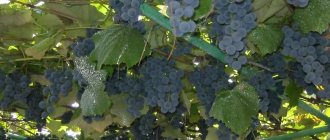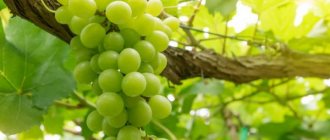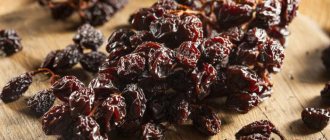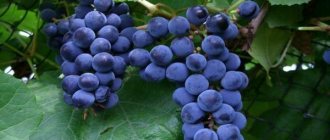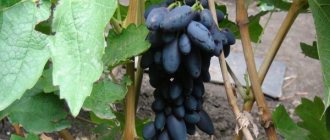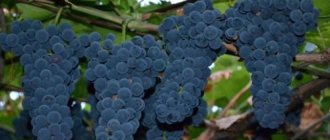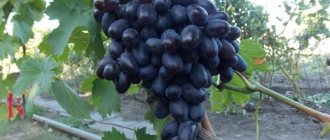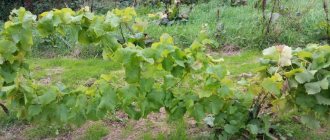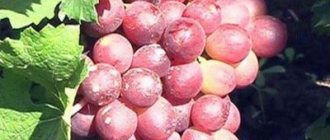Frost-resistant varieties are species hybrids (with rare exceptions) adapted for cold summers. In a short period of time, the berries ripen on the vines. In recent decades, breeders have created varieties that can withstand the harsh conditions of the Russian winter with relative ease.
Winter-hardy varieties are divided into conditionally covering varieties, which need to be removed from their support for the winter and insulated, and non-covering varieties, which do not require this manipulation.
Conditionally covering varieties
This group includes crops that overwinter without negative consequences at a temperature minimum of -27-29°C. In the fall, when the harvest is harvested, the vines are removed and laid on the ground. Light materials are sometimes used as insulation, but these winter-hardy varieties do not require artificial heating. Snow cover is enough for them.
Crystal
A typical wine (technical) variety bred from universal Hungarian and Amur grapes. Favorable zones for cultivation are the North Caucasus and the Lower Volga region, but the variety is unpretentious and tolerates temperatures down to -29 degrees, and can be successfully planted in cold areas.
The berries ripen by mid-August (or later depending on the region). Productivity – from 150 c/ha. The clusters are medium, up to 200 g, the weight of each berry is 1.7-2.5 g. According to reviews from gardeners, Crystal requires protection if grown in the middle zone of the country. Overwinters under light cover.
Alyoshenkin No. 328
An early table variety, bred in the 50s at the Volgograd experimental station. The ripening period is up to 120 days; these grapes can be grown in regions with short summers. The crop is experiencing a strong drop in temperature; at -26 degrees, the berries remain on the vine. But this variety requires shelter for the winter due to the vulnerability of the underground part of the plant.
Suitable for cultivation in greenhouses. Productivity is 20 kg per bush and above. The berries are amber in color, weighing up to 5 g, round. Seeds are not found in all fruits and in small quantities.
Lydia
An American variety known as Isabella Pink. This is evidenced by the color of the berries: they are red with a purple tint. Large and juicy, the fruits are well preserved in severe frosts. Lydia has small, up to 100 g, clusters of small grapes that have an excellent taste.
The variety is planted for wine and for decorative purposes. The harvest ripens by mid-September; about 30 kg of berries are harvested from one bush. This must be done quickly, because... overripe grapes may break off in strong winds.
Lydia is a popular, folk variety. Its advantages include good transportability, long-term storage, and immunity to diseases such as oidium and phylloxera. The disadvantage is that the taste is not for everybody.
Little Dove
A complex hybrid bred in the 80s of the 20th century by breeders from Russia and Ukraine. A technical variety that has a pleasant appearance and good taste. The dove is unpretentious and productive, matures by 130 days, loves moisture, and is frost-resistant down to -26-27 degrees.
The variety is almost not affected by fungal diseases and is resistant to gray rot and mildew. The fruits of Golubka are black and round. The juice contains a lot of coloring substances. Suitable for making homemade wine.
Extra
A variety of American grapes, known to many as Elsinburg. The variety appeared at the beginning of the 20th century and is widely zoned, because. It easily tolerates cold, but in the northern regions it needs shelter. The growth vigor is high, the bushes are powerful, the berries have a unique, sour taste.
Productivity is good. Extra ripens by mid-September. There are disadvantages: the berries do not tolerate transportation very well.
Lady fingers
Known as Khusayne Bely, this variety was bred in Central Asia. The shape of the grapes is oblong, resembling the phalanges of fingers. The taste is sweet, with a pleasant sourness. Ripening time is about 140-150 days.
In central Russia, cultivating Husaine is not recommended, since it can only withstand temperatures down to -15-20 degrees. But it has a good yield, over 40 kg per bush. Read more about this grape variety here.
Moscow stable (Skuin 675)
Bred in Moscow by a Latvian agronomist, this variety is known under the name Skuin 675. An unpretentious early-medium variety, ripens in 130-150 days. Fruitfulness is high, on each shoot there are 3-5 bunches of grapes.
The berries are small and round and have a pineapple aroma. Suitable for wine and fresh consumption. Winter hardiness – up to -28-30 degrees.
Taiga
Amur grapes, which were originally grown in Primorye, and then successfully spread throughout Russia, amazing gardeners with their excellent characteristics: speed of ripening, frost resistance (up to -40 degrees), and resistance to disease.
It grows completely freely in the Moscow region and Siberia. The berries are dark blue, sweet and sour, medium in weight, used in winemaking. The variety is universal. One of the few non-selective varieties.
Moscow region and middle zone
Frost-resistant, uncovered variety of Ontario sweet grapes
This American grape variety is usually used to make white table wine. All the bunches are small - only about 200 grams, the berries have a greenish-golden hue.
Late variety: Ontario ripens only at the end of September. Therefore, it is not suitable for Siberia, since with the local short summer the berries simply do not have time to ripen. The bush can withstand frost down to -30 degrees, has excellent health and strong immunity. It is also worth learning more about whether it is possible to spray during flowering.
Seneca
This variety is perfect for the Moscow region and the middle zone. A universal variety: its greenish-yellow berries can be used in any capacity. At first, the shrub grows slowly, but after it gets stronger, it begins to develop at a much faster pace. The weight of the bunch is 250 grams, one berry weighs 4 grams. Interestingly, the taste of these berries has a light strawberry note, which makes the berries very attractive for fresh consumption. The shrub can tolerate frost down to -25 degrees. It will also be interesting and useful to understand whether it is possible to feed with urea.
Delight
This wonderful variety is especially loved by Belarusian winegrowers, however, it is quite possible to grow it in our Moscow region. Early variety - berries ripen within 125 days. The shrub easily tolerates frosts down to -25-30 degrees, and it is also resistant to all fungal infections. The plant is extremely unpretentious, for which it is especially respected by gardeners. The berries are quite large, the weight of one bunch sometimes reaches a kilogram: as you understand, the yield of the variety is very high
However, it is important to remove excess peduncles during flowering so as not to overload the bush, otherwise the overall yield will decrease
You should also pay attention to how to plant a two-year-old seedling in the spring
Romulus
This variety resembles a quiche due to the lack of seeds. Belongs to early ripening species: greenish-golden berries ripen in 120 days. All one bunch is approximately 300 grams. The taste of the berries is very pleasant - strawberry-pineapple. It should be noted that, despite its frost resistance, this shrub is quite difficult to care for. It does not tolerate excess moisture: this fact immediately affects the yield. In addition, you will have to monitor the overload of the bush, removing excess flower stalks in time. But what frost-resistant table varieties exist, what they are called, and what they look like can be seen here.
Nadezhda Aksayskaya
The variety was bred in the south of Russia, its “parents” are the best representatives of Rostov grapes. The shrub tolerates replanting well, takes root easily, and is able to immediately grow in open ground, without prior greenhouse exposure. The berries themselves are large, the clusters are massive and heavy. Ripening occurs at the end of August, the variety is resistant to diseases and easily tolerates frosts down to -30 degrees.
Lucille
This is a pink grape variety suitable for jams and juices. All bunches - 320 grams, berries - 3 grams. It should be noted that if the summer turns out to be cold, then the berries will taste sour, and vice versa - the sunnier and hotter the weather is, the sweeter the berries will be.
It is clear that in addition to the Moscow region, the grape varieties discussed in this section can be grown in other areas with a similar climate: and this is practically the entire vast central zone of Russia. Not to mention the more southern regions. You can see what the Timur variety looks like in the photo, and you can also learn about the features of growing it at home here.
Frost-resistant, uncovered grape varieties
Varieties of grapes classified as non-covered can be grown in areas where the minimum temperature exceeds -29-35 degrees or more. The berries have a denser skin, and the vine does not require care. For the winter it is left in the same place where it grew (including arches, arbors).
A common popular name for uncovered varieties is Isabella or American, because most species were bred in the USA (and Canada). But the achievements of Russian breeders are also included in this group.
Sharov's riddle
A grape bred in the 70s by a gardener from the Altai region, Rostislav Sharov, and adapted to harsh conditions. It ripens early, withstands cold temperatures of -35°C and stores well for a long time.
It has an average yield. The fruits are sweet, round, with a dense dark red skin. The clusters are large, 300-600 g depending on the region. The variety is very early, the fruits fully ripen by day 110, and in the greenhouse 1.5 weeks earlier.
Northern Saperavi
A variety with a medium ripening period (from 140 days), bred on the basis of an ancient Georgian variety. Technical. It is grown for fresh consumption, production of wines, juices and their coloring.
The berries are oval, dark blue in color, with thick skin and juicy pulp, with a simple taste. The variety is moderately resistant to drought, but tolerates harsh winters, although according to some agronomists in the northern regions it needs insulation.
Productivity from 115 c/ha, stable. Tolerates transportation well. Other advantages include resistance to mildew.
Valiant
A grape that can withstand very low temperatures (-45-46 degrees). Mid-early, growing season – from 130 days. Blue berries appear on the bushes, collected in medium-sized clusters weighing 100 g each.
The variety is characterized by medium sugar content and is rated very highly by gourmets. The variety is used for winemaking and making jelly. Among the disadvantages are the slow development of the vine in the first years, medium-sized fruits (1.5-2.5 g) and average resistance to fungal diseases.
Relines pink seedlis
An American variety developed in the 80s, it has all the advantages of good grapes: early ripening (ripens in 100-110 days), resistance to fungal diseases (does not require chemicals), increased winter hardiness, and absence of seeds.
Its unpretentiousness and vitality make it a desirable crop in temperate latitudes. The taste of Reliance Pink Seedlies is original, with a hint of strawberry. Fruitfulness is good, from one hectare you can get 120-150 centners of harvest. The disadvantage is that the berries are small, up to 2-3 g each.
Maurice Early
A versatile, highly resilient grape developed in North America - one version from Concord seed by Captain John Moore. Known as Early Moore, Moore's early.
The grapes have good yields and are used as an early table variety. Ripening time is the end of September. The clusters and berries are medium in size, the fruits are almost black in color, and have an “isabelle” taste.
Maurice Early is suitable for cultivation in uncovered crops in the Moscow region and other areas of temperate latitude, as well as to the north. Tolerates harsh winters with frosts of -35-36 degrees.
Winchell
A hybrid from America known as Green Mountain. Ripens early, has medium-sized bushes with small light berries. The inside of the fruit is loose, with a strawberry flavor and aroma.
Young shoots ripen well, survive frosts down to -30 and are immune to fungal diseases. Table variety, suitable for fresh consumption and decoration of areas (i.e. gazebo).
Lucille
A universal variety, suitable for creating landscapes, as well as making juices, jellies and jams. The clusters are oval and can reach a weight of 900 g. Lucille has a nutmeg taste; if there is little sun, the berries will sour.
The fruits are not very large, dark pink, purple, and ideal in shape. The variety can withstand frosts down to -30-33 degrees, recommended for cultivation in the Moscow region. Ideal for a small garden in a suburban area.
Productivity is above average, stable, starting from the third year - in the first year the vine gains strength.
Louise Swanson
The American originator E. Swenson developed this frost-resistant grape and named it after his wife Louise. It received variety status in 2001, and was then recognized as one of the best.
Stable harvest. On days 125-135 after the buds appear, the fruits are fully ripe. Dense and medium-sized clusters appear on the bushes. The berries are soft green, moderate acidity, average taste.
Used for wine production. The fruits can remain on the vine for a long time. The variety is not prone to diseases. Tolerates severe frosts down to -35°C, but may suffer from drought.
Amur hybrid varieties
Wild grapes growing in the Ussuri region have been cultivated by people. On its basis, varieties were bred that were immune to cold and disease. Domestic hybrids of Amur grapes prefer acidic soils.
These are non-covering varieties that overwinter without additional insulation. Grapes grown in the Amur region, bred from natural forms, have an advantage over other varieties with similar characteristics.
Amur breakthrough
A popular variety known by other names - Odin, Potapenko 7. Unpretentious in care, not susceptible to diseases, suitable for growing in harsh climates, but does not tolerate drought and strong winds, and in hot dry climates requires abundant watering.
Shoots grow quickly: up to 2.5 m per year. The yield is high, up to 100 kg per bush. The berries are dark in color, large, and ripen towards the end of summer and beginning of September. Sugar variety (23% sugar), suitable for making wine, jam, and juices. Thanks to its thick skin, it tolerates transportation well.
Marinovsky
A variety used for decorative purposes and in winemaking. Among its ancestors is also the Amur grape, from which Marinovsky inherited winter hardiness: it can easily withstand frosts of -30°C. Adult bushes do not need shelter, only young ones.
The grape bushes are spreading, the clusters weigh up to 500-900 g, the shape of the berries is oval, oblong. The skin is dark blue, thin. The taste of the grapes is simple, not very expressive, but harmonious. Yields are consistently high.
Amethyst
A popular variety that has two varieties with similar characteristics: Amethyst Samara and Novocherkassk. Resistant to low temperatures: -25 to -35°C.
The bushes are powerful, spreading, with an abundance of clusters. The berries are elongated, each weighing up to 8 g. Their taste is sweet and sour, reminiscent of a plum.
A special feature of Amethyst grapes is that wasps do not flock to its berries. Amethyst is a very early variety, fully ripens in 90-110 days, by the end of summer. And the first harvest can be harvested the next year after planting.
Advantages of frost-resistant species
The most important advantage of the frost resistance of this plant is that there is no need to create a shelter for it for the winter. At the same time, you can choose table and dessert, dark and light varieties.
If you properly care for the bush at a young age, then, having strengthened, it will be strong enough to withstand frosts down to −33 ° C. Gradual hardening will benefit the plant. To do this, it is enough to annually reduce the period of stay in the bush shelter.
For your information! In the fall, the bush should be covered a little later than last year, and in the spring it should be opened a little earlier.
The most productive varieties of American selection
In the USA, viticulture is no less popular than in our country. 15 states are advanced in the production of this berry, but in the rest this branch of agriculture is thriving. Breeders are successfully developing new varieties that are immune to frost. Many of them are taking root in Russia.
Alpha
Non-covering technical grade that can withstand critical temperatures down to -40. Unpretentious and stable, can be grown in the north of Russia.
Ripens late, in September-October (110-145 days). On vigorous, powerful bushes, medium-sized clusters appear, weighing 100-250 g; the berries are black and round. A minor drawback is their high acidity. Alpha's yield is excellent; from 1 hectare it is possible to collect about 150-180 centners.
One of the disadvantages of the variety is its susceptibility to chlorosis.
Other technical grape varieties are described here.
Prairie Star
White wine grapes come from the USA (E. Swenson), ripening in mid-September. In the first years, the bushes develop moderately, then they grow, and often pinching of growing shoots is required.
It bears fruit well; 150 kg of berries can be harvested from one quintal. The grape bunches are medium-sized, oblong, dense. The fruits are round, yellow-green, and have a crispy taste.
Wine from Prairie Star has a long aftertaste. The variety is promising for cultivation in northern regions; it tolerates frosts down to -38°C.
Cardinal
An early variety, ripening by 110 days. Bred in the 30s of the last century in California. Suitable for long-term storage, but requires good care.
In northern areas, shelter may be required during the spring months when recurrent frosts occur. The grapes can withstand temperatures down to -20°C.
One of the disadvantages of Cardinal is its poor susceptibility to pests and diseases. Pros: large berries, weighing 9 g, excellent taste. The ratio of sugar and acid is 2:1. Productivity is high, but not always stable.
Isabel
A natural hybrid, known since the 19th century and which has become one of the most widespread in the world. This is a very durable grape from the USA, unpretentious in care, which can be grown throughout Russia and used for decorative purposes.
Isabella ripens late, by mid-autumn, but is characterized by excellent taste, high yield, and resistance to diseases (but not oidium). The berries are dark, with slimy pulp inside. Each fruiting body reaches a mass of 2-3 g. The grapes are consumed fresh and used for wine.
Kay Gray
An early ripening variety of American selection, characterized by high yield. Small juicy amber-colored berries appear on powerful bushes.
Not susceptible or partially susceptible to many diseases (gray and black rot, oidium, etc.). According to tests conducted in the USA, Kay Gray can withstand temperatures down to -42 degrees. Ideal for growing in northern regions.
Despite the fact that the variety is technical, wine is not made from it - during fermentation of the berries, methyl alcohol is released. You can make juice from these grapes.
Aleshenkin
This variety was developed by mixing pollen from several varieties of garden grapes. Its main advantages are the excellent taste of the berries, early ripeness and high yield. The bunches of Aleshenkin grapes are very large and can reach a weight of 0.7-2.5 kg. The color of the berries of this variety is amber with a slight white coating. Each berry can gain weight up to 5 g. Its resistance to diseases is average.
Early domestic varieties
The colder the region, the shorter the growing season of grapes should be so that the vine has time to gain strength and the fruits to ripen and be ready for consumption before the onset of rain and cold weather.
In areas with short summers, early varieties are chosen for planting. Their growing season lasts less than 4 months. Among them, it is worth paying attention to the varieties of Russian selection, bred specifically for the northern regions.
Cheremushka Siberian
Variety selected by Sharov. Early ripening grapes (growing season 110 days), the berries of which are small in size, especially in the first years, but pleasant in taste and aroma. It even looks like a bird cherry, hence the name.
The fruits can remain on the bush in a mature form for a long time. Siberian cherry tree tolerates cold temperatures below -25°C well, produces good yields and does not need shelter during the winter months.
Positive qualities include small seeds, high ripening of the vine, and resistance to parasites.
Bashkir early
A variety obtained by breeder L. Strelyaeva in the 1970s based on the Amursky variety. Bashkir grapes are highly resistant to frost, including the roots, and ripen early.
The growth power is average, the clusters are small, but the berries reach a weight of 10 g or more. The fruits are dark in color, sweet and sour. The yield of the variety is from 140 c/ha and above. It is not susceptible to some fungal diseases and parasites, but is not resistant to oidium.
Tukay
An unpretentious table variety, bred in Novocherkessk and intended for cultivation in any part of the country.
Ideal soils: loams, limestone, sandstone. Tukai ripens quickly; already at 90-100 days the grapes are ready for consumption. They are large (4 g on average), dense, and have a nutmeg taste. With good care, the berries remain on the vine for a long time and easily tolerate the first frosts.
White Muscat (Shatilova)
A hybrid variety of grapes that ripens by 115 days. The bushes are vigorous and produce excellent harvests. The weight of the bunches can reach 1 kg. The fruits are large, fleshy, with a nutmeg aroma.
Shatilov's grapes are resistant to oidium, mildew, and frosts down to -27°C. It winters well under a thick layer of snow, but does not always survive recurrent frosts.
Other very early frost-resistant varieties
There are other early grape varieties:
| Grape varieties | Growing season |
| Cardinal | 110 days |
| Sharov's riddle | 110 days |
| Relines pink seedlis | 105 days |
| Amethyst | 90 days |
Unpretentious varieties
Very often, gardeners in Siberia, the Central regions and the Urals grow unpretentious frost-resistant table grape varieties. The berries of these varieties are inferior in taste to dessert varieties. However, they do not require increased attention. The most popular varieties of this group include:
- Tukay;
- Codrianka;
- Aleshenkin.
All of these are very good winter-hardy, non-covering grape varieties for the Moscow region. These varieties feel great in the Urals, Siberia, and the Volga region.
Varieties by region
Frost-resistant varieties are zoned for different parts of the country: the Far East, the Urals, the Non-Black Earth Region, and Primorye. Some species have difficulty withstanding warm winters with frequent thaws. The fruiting of the variety is affected by the average temperature of the warmest month of the year, which is usually July. The harvest will be of good quality if the temperature is:
- not lower than 18 degrees for non-hybrid varieties;
- at least 12-14 for hybrids.
Best crops for different areas:
| Recommended areas (for cultivation) | Varieties |
| Central Russia | Alpha, Tukay, Isabella, Northern Saperavi, Lucille, Aleshenkin, Crystal |
| Northwest | Tukay, Skuin 675 (Moscow), Amethyst, Sharov's Riddle, Relines pink seedlis |
| Siberia and Far East | Amur Breakthrough, Sharov's Riddle, Aleshenkin, Skuin 675, Taiga, Siberian Cheryomushka, Lydia, Isabella |
| Ural region | Valiant, Lucille, Bashkir early, Muscat Bely, Aleshenkin |
| Altai | Cheremushka Siberian, Tukay, Extra |
Best for different growing regions
For the coldest regions of Siberia, it is recommended to choose frost-resistant varieties that can withstand temperatures down to -40°C. These are the Amur breakthrough grapes, Lydia, Aleshenkin. With such varieties, gardeners can be sure that the shoots will not freeze and will delight you with juicy and large berries in the summer.
For milder frosts (up to -25°C), the grapes chosen are Lady's Fingers, Tukay, and Cardinal. For the winter, they are covered with thick burlap, and the protection is removed at the end of April or beginning of May. Such varieties are suitable for the Chelyabinsk, Sverdlovsk, and Orenburg regions.
In central Russia and the Moscow region, Isabella, Pink Pearl, and Taifi grapes are grown. As a rule, the lands here are more suitable for growing fruit crops. The grapes rarely get sick and are not a hassle to care for.
The most frost-resistant varieties
Let's consider varieties that can survive after frost:
| Variety | Temperature maximum that can withstand |
| Lydia | -30°C |
| Alpha | -30-39 °C |
| Amur breakthrough | -40 °C |
| Louise Swanson | -35-40 °C |
| Sharov's riddle | -40 °C |
| Valiant | -45 °C |
The popularity of frost-resistant grapes among gardeners in our country (including amateurs) is due to the fact that they can be grown not only in the southern regions and have stable harvests every year. This berry is unpretentious in maintenance, especially when it comes to hybrids that can withstand harsh weather conditions and are immune to fungal diseases.
0
0
Copy link

